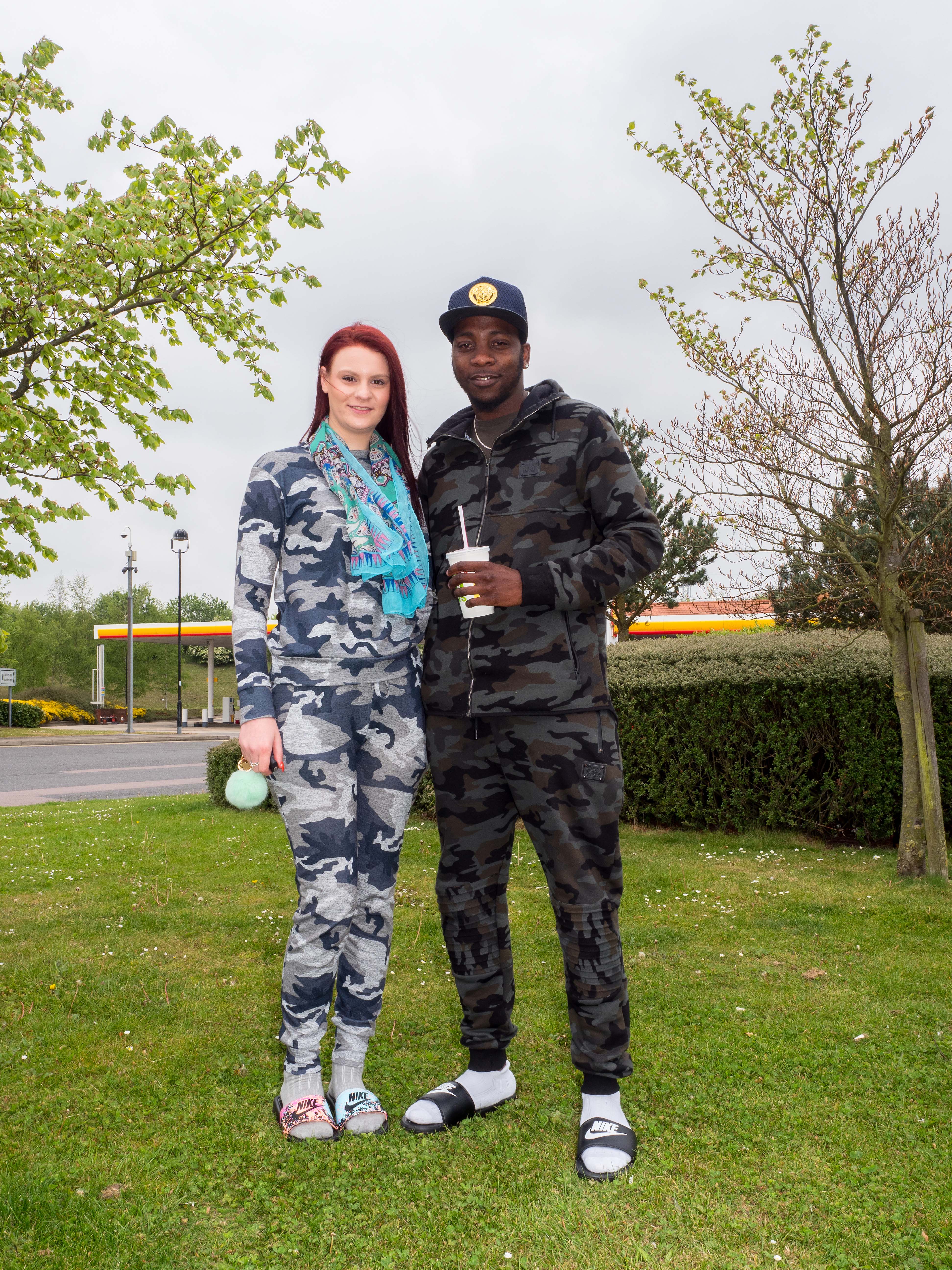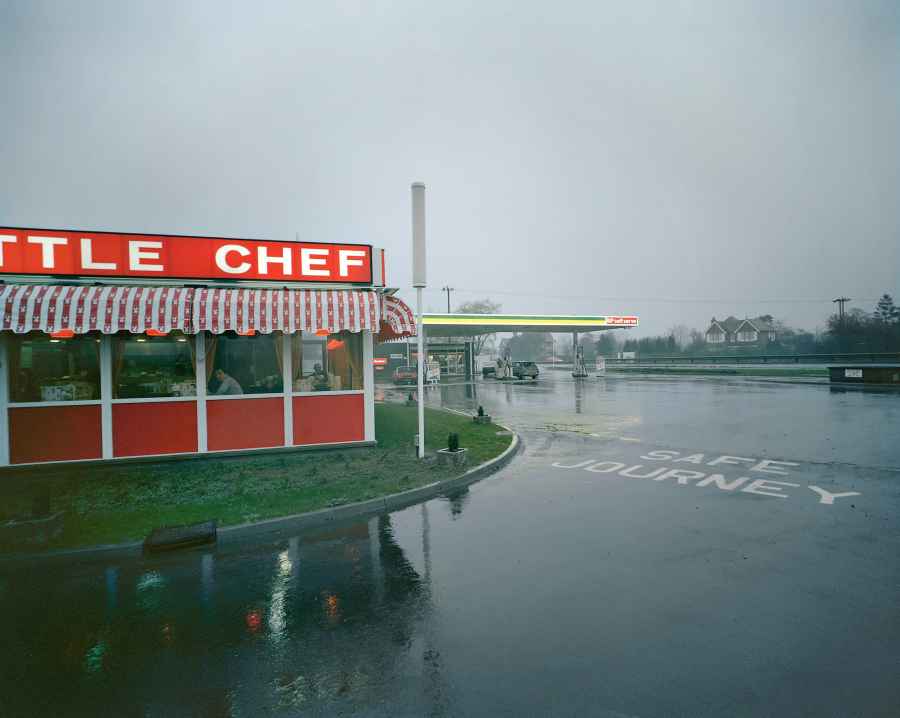The early 1980s in Britain. A time of Tory prime minister Margaret Thatcher, rising unemployment, industrial action, war in Northern Ireland and New Wave music. Black & white photography dominated, the 35mm camera and 50mmm lens prevailed. Front-page press photographs were stark and often shot close. Martin Parr had published his first book, Bad Weather, in black & white. Colour photography was rare, it was happy, decorative, largely derided and dismissed by the photo-establishment. Colour was used by amateur photographers for family and holiday snaps.

Little Chef In Rain, St Neots, Cambridgeshire, May 1982
Throughout 1981 and 1982, photographer Paul Graham photographed the life and landscape along Britain’s longest numbered road. A year later, he self-published A1 – The Great North Road. It was large-format photography, shot in colour, at a distance. It was controversial. It was brilliant. When I first viewed the book at art college in 1990, I knew it was a journey I would one day make. I’d never seen or been to the places Graham photographed. The cafes and service stations more exotic than a David Attenborough documentary.

Young Executives, Bank of England, London, November 1981
I’m not the first photographer to have been significantly impacted by the book and with MACK having recently republished it, I doubt I’ll be the last. (Graham went on to complete Beyond Caring, 1985, documenting the conditions in social security and unemployment benefit offices across Britain, and Troubled Land, 1986, dealing with signs of deep political division within the landscape of Northern Ireland at the time of the Troubles – both of which became iconic bodies of work and also to be republished by MACK).

Cafe Assistants, Compass Cafe, Colsterworth, November 1982
Photographer, educator and recipient of the 2015 Jerwood/Photoworks Award, Matt Finn, recalls Graham coming to talk at the University of Derby in 1991 where Finn was studying photography: ‘I’ve met him since and he’s the consummate professional, at ease with his persona and photography. Back then he wasn’t. It had been eight years since the A1 was published and he was slightly disheveled and not the confident person he has come to be with he bodies of work he’s done.
What really interested me about the A1 was I’d never seen a British photographer do a road trip. That seemed to be the preserve of American photographers – Robert Frank’s The Americans and Lee Friedlander’s The American Monument. That struck me. It was of topical substance there and then. It’s gained traction over the years, with Thatcher and how people have looked back at her. It paved the way for British colour photographers like Nick Waplington, Anna Fox and to a lesser extent, Tom Wood.’
Context
Independent photographer, filmmaker and Leader of BA (Hons) Photography programmes at The Northern School of Art, Jamie MacDonald, believes the work remains necessary to teach today.

Couple, Washington Services, Tyne & Wear, May 1982
‘I think it’s good, it has purpose and sets out to achieve something. It’s interesting for students to understand what the photographs mean by having them attached to a context that has a beginning and a middle and an end. Some students find the pictures boring, some nostalgic, others will take to it and research more of his work.’
One such student is 19-year-old James Tappenden. ‘I really enjoyed the journey I experienced through the book, starting off from the bustling city space and then the gradually changing landscape which involves coastal areas and long stretches of farmland. I think it represents positive aspects of what it means to be from the north of England, the diversity is something special. This book (and others by Graham) have influenced my approach to photography, by looking for beauty in the mundane aspects of your own life. Something as straightforward as a road has so much potential – the subjects and landscapes you can find is incredibly unique – and I have tried to apply that ideology to my own work, to look around and let my surroundings guide me.’
Graham’s original book has 40 single colour plates, each published on the right-hand page, a brief description of what, where and when on the left, a simple and powerful format. ‘Looking back at the pictures now, you realise how intelligent the edit is. Even if you just look at the first and last picture – the bankers laughing in their polished suits and stark figure of the woman in blue, straight away you think of Thatcher and this period of individualism, capitalist growth and explosion of wealth. What an amazing picture to start this journey on – a period of time that was going to completely change the course of British political history. As we move north, you go through the heart of Britain, of political and economic change and we finish with a very stark green photograph which is much more minimalistic and formal,’ explains British artist-photographer, Simon Roberts, whose work deals with our relationship to landscape and notions of identity and belonging.
‘Today looking at the original book design, I’m struck by how modern it is. We’re very aware of the symmetry now in contemporary photo books. Back then there were very few British documentary books, it’s a totally different animal. For me the A1 is a forerunner of where contemporary photography books are,’ adds Finn.

City workers check their phone. St Paul’s, London.
Dench’s journey
As the spine of the country, beginning in the city of London and ending 410 miles later in Edinburgh, the A1 has consistently told the story of Britain from being paved by the Romans, marched along by King Harold to Thatcherism – it’s a road that divides as much as it connects. Thirty-six years after Graham’s A1 was published, after another political upheaval, I felt it was my time. Brexit had ruptured the country.
The faultlines that existed across the country were exacerbated by the nation’s 2016 decision to leave the European Union and the unconvincing outcome of the June 2017 general election. It was a time of uncertainty and I had questions. Is life in Britain about to become better or worse? Will employment opportunities increase or diminish? Will the economy and industries collapse or thrive? Are the British worried about the future and do elderly people, the majority of whom voted Leave, care less about it than the young? Will Britain leaving the EU mean that immigrants will feel unsafe and be forced to leave? How proud do people feel to be British? Graham’s book was my map, and the A1 my route of certainty through a nation on the verge of change.

After a break at an OK DINER, Vilma and Darius are continuing on by car to Sheffield. Both Lithuanian , they have lived in Britain for over a decade and aren’t concerned about their residency after Brexit. Newark, Nottinghamshire
Driving the length of the A1, Britain didn’t seem full. At times it felt lonely. The east coast of Scotland is largely empty except for the occasional nuclear power station, cement factory and caravan park. The Labour voters I met along the A1 said they are doing okay. The Conservative voters I met said they are doing okay. If the stoicism, drive and grit of the people I met is an accurate reflection of the nation, Britain is going to be okay. When a set of my pictures from the A1 went live on BBC online, it had around 1.4 million hits the first morning with most viewers scrolling to the bottom, which I’m told is about as good as it can get. There is nostalgia and a fondness for the A1. I still get emails from those who travel along it, advising where to get a decent brew and the best stomach-busting, full-English breakfast.
‘I’ve had a lot of real starts. I like to start over with every piece of work. Part of an artist’s job is to scare themselves, to frighten yourself and challenge yourself every time. I can’t imagine having one idea and making one piece of work and just repeating it for 30 or 40 years. I cannot imagine that as life, a creative life, for me it’s wrong. For me to challenge and change and grow is the most interesting thing,’ reveals Graham in an interview at Paris Photo.

Challis Cooper (20) and Arnold (22) take a break at Baldock Extra Motorway Services, on their way to visit family in Great Yarmouth. Radwell, Baldock, Bedfordshire.
Graham’s career continues to flourish and change in New York where he now lives. His photography ignited with the book A1 – a road he fondly travelled along on holiday with his family as a kid. The reportage has become a backbone of British social documentary photography. I didn’t witness much that remained from Graham’s original journey, a bend in the road, a roundabout, the Ferrybridge Power Station. What has survived is a convoy of fans and photographers driven to succeed by Graham and a book that every aspiring photographer should pull over to study from time to time.
Tips & takeaways
If you want to make the photographic journey along the A1, don’t let the fact that many photographers have, put you off. Learn from them, do it differently or wait a few years. Trust your instinct and have something new to say. You could make your trip about the food or the unusually high numbers of sex shops and swingers clubs along the way. Perhaps document the truck drivers and truck stops or make a reportage on the hotels, pubs and bars, architecture or places of worship. Shoot it in black & white! Always drive safely.
Further reading
Our best documentary, street and architecture photography tips







